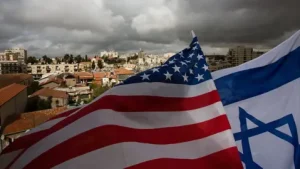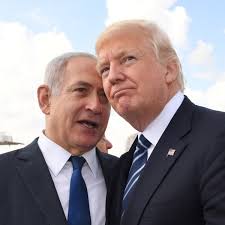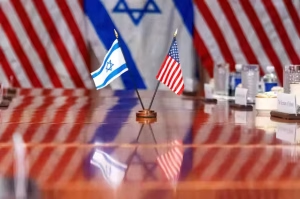U.S.A. – On April 7, 2025, U.S. President Donald Trump hosted Israeli Prime Minister Benjamin Netanyahu at the White House to discuss one of the most pressing issues facing the Middle East: the war in Gaza. As the two leaders stood side by side, Trump expressed optimism that the conflict would come to an end soon, indicating a potential shift in the ongoing hostilities that have resulted in immense human suffering and geopolitical instability. This marked the moment when Trump meets Netanyahu during a pivotal juncture of the Gaza conflict.
The Gaza Conflict: A Complex Crisis

The war in Gaza, which reignited in late 2023, has intensified through 2024 and into early 2025, causing mass displacement and humanitarian crises. Israeli military operations have aimed to neutralize Hamas, a militant group that governs the Gaza Strip. The Israel Defense Forces (IDF) expanded a buffer zone nearly two miles deep inside Gaza’s northern and eastern borders. This expansion resulted in the destruction of thousands of homes and infrastructure, effectively making large swathes of Gaza uninhabitable.
By April 2025, Israel controlled over half of Gaza’s territory. The IDF argued that these actions were necessary to ensure the safety of Israeli citizens and prevent future attacks by Hamas. However, this approach has received significant international scrutiny. Human rights groups have condemned the widespread destruction and the rising civilian death toll. Testimonies from soldiers suggest a strict targeting policy that resulted in civilian casualties, especially near the newly established buffer zones. It is in this context that Trump meets Netanyahu to explore possible resolutions.
International Response and Humanitarian Concerns
Global condemnation of the war in Gaza has mounted, with many countries and international organizations calling for an immediate ceasefire. Reports of attacks on hospitals and medical facilities have added to the humanitarian alarm. One notable incident involved a strike on a major hospital in southern Gaza, leading to multiple fatalities and severely limiting access to emergency care.
Humanitarian organizations operating in Gaza have described catastrophic conditions. Access to clean water, electricity, and medical supplies is minimal. Displaced families are living in makeshift shelters, and the threat of disease looms large. Aid convoys often face difficulties entering the territory due to security concerns, further exacerbating the crisis. Trump meets Netanyahu amid these calls for urgent international intervention.
Netanyahu’s Strategic Goals and Domestic Pressure


Israeli Prime Minister Benjamin Netanyahu has remained resolute in his pursuit to dismantle Hamas. He has referred to the conflict as a “war of rebirth” for Israel, one that is necessary for long-term peace and national security. However, Netanyahu has been criticized for lacking a clear post-war governance plan for Gaza.
Despite achieving some military goals, his government has yet to define who will govern Gaza once Hamas is removed. The absence of a coherent political strategy for the post-conflict period has drawn criticism from within Israel and from international allies. Moreover, growing public discontent in Israel has increased pressure on Netanyahu to produce a definitive resolution. With such mounting challenges, Trump meets Netanyahu to push for a clearer political trajectory.
Trump’s View on the Gaza War Resolution
During the joint appearance at the White House, President Trump reiterated his stance that the war in Gaza must end sooner rather than later. He acknowledged Israel’s right to defend itself but warned against dragging the conflict out indefinitely. Trump said he believed the war would end relatively soon and emphasized the need for pragmatic diplomacy.
Trump’s stance aligns with his broader foreign policy goals. He has consistently advocated for a balance between strong defense policies and de-escalation strategies. In private conversations, Trump meets Netanyahu to encourage a conclusion that avoids further international backlash.
Each time Trump meets Netanyahu, the urgency around the Gaza conflict is brought to the forefront of global discourse. Trump meets Netanyahu to reinforce his belief that prolonged war only deepens regional instability. Trump meets Netanyahu to insist that the time for negotiation and compromise is now. As Trump meets Netanyahu, he highlights the importance of diplomacy over militarism.
During these meetings, Trump meets Netanyahu to outline the potential consequences of continued warfare on Israel’s international standing. Trump meets Netanyahu in the spirit of seeking common ground despite political differences. As Trump meets Netanyahu behind closed doors, he raises humanitarian concerns alongside strategic issues. Trump meets Netanyahu to review the roadblocks to peace and to strategize pathways to overcome them. Through direct dialogue, Trump meets Netanyahu to develop joint initiatives aimed at rebuilding Gaza and restoring hope. Ultimately, Trump meets Netanyahu with the intent of shaping a future where both sides benefit from lasting peace.
The Vision for Gaza’s Reconstruction
One of the more ambitious aspects of Trump’s vision involves the reconstruction of Gaza. He has proposed turning the region into a high-tech and tourism-friendly zone, calling it the “Riviera of the Middle East.” According to Trump, such a transformation would require significant investment, international cooperation, and a stable government in Gaza post-conflict.
Though many view the proposal as idealistic, it reflects the long-term ambition to foster peace through economic development. Trump’s administration has expressed a willingness to lead these reconstruction efforts, provided that a comprehensive Gaza war resolution is achieved. As Trump meets Netanyahu, he promotes this vision as a cornerstone of peace-building.
Obstacles to a Lasting Ceasefire

Despite the diplomatic overtures, a permanent ceasefire remains elusive. Hamas has demanded that Israel halt its military operations as a precondition for releasing the remaining hostages. Israel, in turn, has rejected these demands, arguing that a unilateral cessation would allow Hamas to regroup.
Meanwhile, no clear plan exists for what comes next in Gaza. While some officials have suggested a multinational force to oversee the transition, no such agreement has materialized. The absence of a governance strategy continues to be a key barrier to any lasting Gaza war resolution. These are among the issues Trump meets Netanyahu to deliberate with urgency.
U.S.-Israel Economic Cooperation
Beyond the war, economic topics also featured prominently in the White House discussions. President Trump and Prime Minister Netanyahu reached an agreement to remove Israeli tariffs on U.S. imports. This move is aimed at reducing the trade deficit and stimulating economic growth in both nations.
The leaders emphasized that strengthening economic ties is essential for long-term geopolitical cooperation. Removing trade barriers could set a precedent for broader regional economic integration, especially if peace is restored in Gaza and surrounding areas. This economic dialogue gains new weight as Trump meets Netanyahu to reinforce bilateral ties.
Political Implications in the U.S. and Israel
The Gaza war resolution is also significant from a political standpoint. In the United States, Trump’s handling of foreign affairs is likely to influence his re-election prospects. A successful diplomatic resolution in Gaza could bolster his credentials as a global peacemaker.
In Israel, Netanyahu’s future is closely tied to the outcome of the conflict. Public opinion is increasingly polarized, with some supporting continued military operations and others demanding an end to the war. The next few months will likely be critical for both leaders. As such, when Trump meets Netanyahu, the stakes are both regional and deeply personal.
Regional and Global Stakes
The Gaza conflict has implications far beyond the immediate region. Neighboring countries such as Egypt, Jordan, and Lebanon are monitoring the situation closely. Tensions along Israel’s northern border have already flared, with sporadic clashes involving Hezbollah militants.
The broader international community is concerned that the conflict could escalate into a wider regional war. As such, achieving a Gaza war resolution is not only a moral imperative but also a geopolitical necessity. Trump meets Netanyahu to avert these risks and guide the region back to stability.
Future Outlook: Is Peace Possible?
Despite the complexities, there remains cautious optimism that peace can be achieved. Trump’s proactive engagement, combined with mounting international pressure, could create the momentum needed for a diplomatic breakthrough.
The key to a sustainable resolution will be a comprehensive strategy that addresses military, political, economic, and humanitarian dimensions. Only through coordinated global efforts can a lasting Gaza war resolution be realized. Therefore, each time Trump meets Netanyahu, the urgency of results becomes even more pronounced.
Every time Trump meets Netanyahu, new challenges and opportunities emerge. Trump meets Netanyahu with the hope of bridging deeply rooted divides and implementing practical steps forward. Trump meets Netanyahu to align both nations’ strategies and convey the gravity of the humanitarian situation. With each encounter, Trump meets Netanyahu amid increasing calls for accountability and measurable results.
As the international community watches closely, Trump meets Netanyahu to push for a more coordinated peace effort. Trump meets Netanyahu to prioritize urgent issues including hostages, displaced civilians, and infrastructure repair. These high-stakes discussions are where Trump meets Netanyahu with a renewed sense of resolve. Trump meets Netanyahu to move the focus from war to peace-building.
It is in these recurring moments that Trump meets Netanyahu and urges the creation of a multi-national coalition for peace enforcement. Trump meets Netanyahu once again to revisit the economic roadmap for Gaza’s future and to chart political progress. Each time Trump meets Netanyahu, they reaffirm their partnership and shared responsibility for regional stability.
Final Word
The road to peace in Gaza remains fraught with complexities, historical grievances, and entrenched political ideologies. However, the meeting between President Donald Trump and Prime Minister Benjamin Netanyahu represents a pivotal moment in efforts toward a Gaza war resolution. Both leaders stand at a crossroads—balancing domestic pressures, international scrutiny, and the urgent need to mitigate one of the worst humanitarian crises in recent memory. This isn’t the first time Trump meets Netanyahu, but the context has never been more crucial.
A Gaza war resolution is not simply a matter of military withdrawal or ceasefire agreements. It encompasses the rebuilding of trust, the establishment of governance mechanisms, the assurance of security for both Israelis and Palestinians, and the healing of deep societal wounds. As such, any path forward must be rooted in mutual recognition and a willingness to engage in sustained dialogue. As Trump meets Netanyahu again, this vision remains top of the agenda.
The idea of transforming Gaza into a zone of prosperity, championed by Trump, while ambitious, speaks to a broader vision that peace must also bring tangible improvements to people’s lives. Reconstruction efforts, economic incentives, and regional cooperation must all align to give this vision a chance of becoming reality. Yet, without concrete steps and a commitment to diplomatic and humanitarian principles, even the most visionary plans will falter. Every time Trump meets Netanyahu, these priorities are reiterated.
Netanyahu’s resolve to eliminate Hamas as a security threat is understandable from a national security standpoint. However, the lack of a post-war governance strategy presents a significant challenge. A vacuum in Gaza’s political structure could lead to chaos or the rise of other extremist groups, complicating the situation further. Recognizing this, Trump meets Netanyahu to press for long-term planning.
Trump’s advocacy for ending the conflict and encouraging negotiation reflects a strategic understanding of U.S. influence in the region. His administration now faces the task of turning words into actions—leveraging economic, diplomatic, and political tools to foster peace. U.S. involvement, along with multilateral support, remains essential for creating a viable peace process. Each time Trump meets Netanyahu, the pressure to deliver tangible results increases.
Ultimately, the Gaza war resolution requires the courage to make difficult compromises, the foresight to think beyond immediate political gains, and the compassion to prioritize human life and dignity. With the international spotlight focused on their next moves, both Trump and Netanyahu carry the responsibility to steer this moment toward a just and lasting peace. History will remember not just that Trump meets Netanyahu—but whether their meeting led to meaningful, lasting change.

